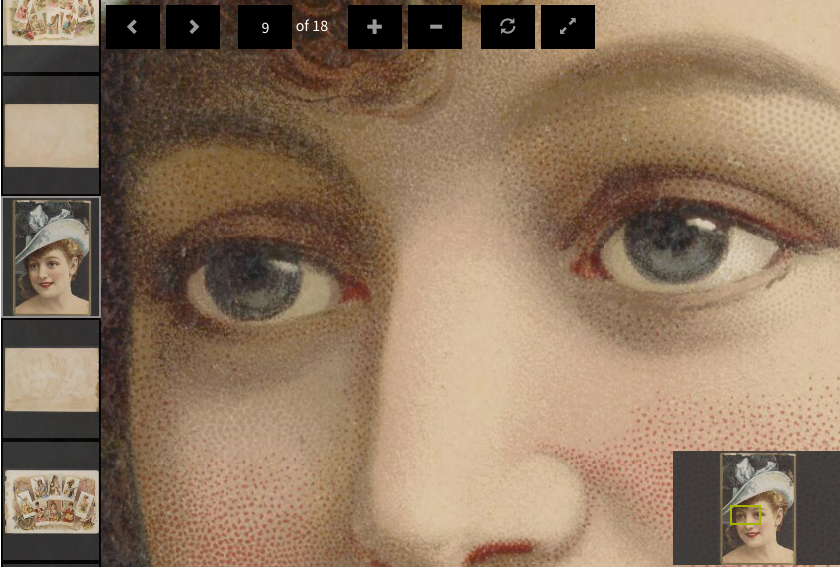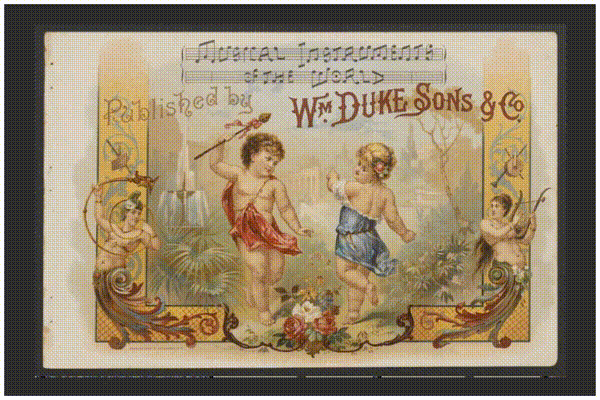Our new W. Duke & Sons digital collection (released a month ago) stands as an important milestone for us: our first collection constructed in the (Hydra-based) Duke Digital Repository, which is built on a suite of community-built open source software. Among that software is a remarkable image viewer tool called OpenSeadragon. Its website describes it as:
“an open-source, web-based viewer for high-resolution zoomable images, implemented in pure Javascript, for desktop and mobile.”


In concert with tiled digital images (we use Pyramid TIFFs), an image server (IIPImage), and a standard image data model (IIIF: International Image Interoperability Framework), OpenSeadragon considerably elevates the experience of viewing our image collections online. Its greatest virtues include:
- smooth, continuous zooming and panning for high-resolution images
- open source, built on web standards
- extensible and well-documented
We can’t wait to get to share more of our image collections in the new platform.
OpenSeadragon Examples Elsewhere
Arthur C. Clarke’s Third Law states, “Any sufficiently advanced technology is indistinguishable from magic.” And looking at high-res images in OpenSeadragon feels pretty darn magical. Here are some of my favorite implementations from places that inspired us to use it:
- The Metropolitan Museum of Art. Zooming in close on this van Gogh self-portrait gives you a means to inspect the intense brushstrokes and texture of the canvas in a way that you couldn’t otherwise experience, even by visiting the museum in-person.

Self-Portrait with a Straw Hat (obverse: The Potato Peeler). Vincent van Gogh, 1887. - Chronicling America: Historic American Newspapers (Library of Congress). For instance, zoom to read in the July 21, 1871 issue of “The Sun” (New York City) about my great-great-grandfather George Aery’s conquest being crowned the Schuetzen King, sharpshooting champion, at a popular annual festival of marksmen.
![The sun. (New York [N.Y.]), 21 July 1871. Chronicling America: Historic American Newspapers. Lib. of Congress.](https://blogs.library.duke.edu/bitstreams/files/2015/11/ny-sun-chronicling-america-1024x330.jpg)
The sun. (New York [N.Y.]), 21 July 1871. Chronicling America: Historic American Newspapers. Lib. of Congress. - Other GLAMs. See these other nice examples from The National Gallery of Art, The Smithsonian National Museum of American Museum, NYPL Digital Collections, and Digital Public Library of America (DPLA).
OpenSeadragon’s Microsoft Origins
The software began with a company called Sand Codex, founded in Princeton, NJ in 2003. By 2005, the company had moved to Seattle and changed its name to Seadragon Software. Microsoft acquired the company in 2006 and positioned Seadragon within Microsoft Live Labs.
In March 2007, Seadragon founder Blaise Agüera y Arcase gave a TED Talk where he showcased the power of continuous multi-resolution deep-zooming for applications built on Seadragon. In the months that followed, we held a well-attended staff event at Duke Libraries to watch the talk. There was a lot of ooh-ing and aah-ing. Indeed, it looked like magic. But while it did foretell a real future for our image collections, at the time it felt unattainable and impractical for our needs. It was a Microsoft thing. It required special software to view. It wasn’t going to happen here, not when we were making a commitment to move away from proprietary platforms and plugins.
Sometime in 2008, Microsoft developed a more open Javascript-based version of Seadragon called Seadragon Ajax, and by 2009 had shared it as open-source software via a New BSD license. That curtailed many barriers for use, however it still required a Microsoft server-side framework and Microsoft AJAX library. So in the years since, the software has been re-engineered to be truly open, framework-agnostic, and has thus been rebranded as OpenSeadragon. Having a technology that’s this advanced–and so useful–be so open has been an incredible boon to cultural heritage institutions and, by extension, to the patrons we serve.
Setup
OpenSeadragon’s documentation is thorough, so that helped us get up and running quickly with adding and customizing features. W. Duke & Sons cards were scanned front & back, and the albums are paginated, so we knew we had to support navigation within multi-image items. These are the key features involved:
- Sequence Mode. Previous/Next navigation through an image sequence.
- Image Reference Strip. Clickable thumbnails.
- Viewport Navigator. Small thumbnail showing current position in overall image.
- IIIF Tile Sources. Provide the viewer with an array of IIP-generated IIIF info.json URLs: it does the rest.
Customizations
Some aspects of the interface weren’t quite as we needed them to be out-of-the-box, so we added and customized a few features.
- Custom Button Binding. Created our own navigation menu to match our site’s more modern aesthetic.
- Page Indicator / Jump to Page. Developed a page indicator and direct-input page jump box using the OpenSeadragon API
- Styling. Revised the look & feel with additional CSS & Javascript.
Future Directions: Page-Turning & IIIF
OpenSeadragon does have some limitations where we think that it alone won’t meet all our needs for image interfaces. When we have highly-structured paginated items with associated transcriptions or annotations, we’ll need to implement something a bit more complex. Mirador (example) and Universal Viewer (example) are two example open-source page-viewer tools that are built on top of OpenSeadragon. Both projects depend on “manifests” using the IIIF presentation API to model this additional data.
The Hydra Page Turner Interest Group recently produced a summary report that compares these page-viewer tools and features, and highlights strategies for creating the multi-image IIIF manifests they rely upon. Several Hydra partners are already off and running; at Duke we still have some additional research and development to do in this area.
We’ll be adding many more image collections in the coming months, including migrating all of our existing ones that predated our new platform. Exciting times lie ahead. Stay tuned.
Animated Demo



